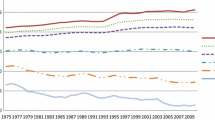Abstract
This article shows that, contrary to common wisdom, the insurgence of a multiplicity of clusters in the distribution of income is not necessarily against the hypothesis of absolute convergence. Using data for the world economies, the US states, the EU regions, and the Italian regions, we find that despite the distribution of income per capita for both the world economies and for the Italian regions is multimodal, only in the former case absolute convergence can be rejected. Similarly, although the distributions for the EU regions and the US states are both unimodal, convergence is unambiguously taking place in the latter case only. We show that these results are consistent with the neoclassical model of growth in the presence of non-convexities in production. We conclude that polarization in the distribution of per capita incomes is neither a sufficient nor a necessary condition to reject the absolute convergence hypothesis.
Similar content being viewed by others
References
Abramovitz M (1986) Catching up, forging ahead and falling behind. J Econ Hist 46: 385–406
Barro RJ, Sala-i-Martin X (1991) Convergence across States and Regions. Brookings Paper Econ Act 1: 1107–1182
Barro RJ, Sala-i-Martin X (1992) Convergence. J Polit Econ 100: 223–251
Baumol WJ (1986) Productivity growth, convergence, and welfare: what the long run data show. Am Econ Rev 75: 1072–1085
Beaudry P, Collard F, Green D (2005) Changes in the world distribution of output-per-capita 1960–98: how a standard decomposition tells an unorthodox story. Rev Econ Stat 87: 741–753
Bianchi M (1997) Testing for convergence: evidence from non-parametric multimodality test. J Appl Econ 12: 393–409
Duclos J-Y, Esteban J, Ray D (2004) Polarization: concepts, measurement and estimation. Econometrica 72: 1737–1772
Galor O (1996) Convergence? Inference from theoretical models. Econ J 106: 1056–1069
Islam N (2003) What have we learnt from the convergence debate. J Econ Surv 17: 309–362
Johnson PA (2000) A nonparametric analysis of income convergence across the US states. Econ Lett 69: 219–223
Johnson NL, Kotz S, Balakrishnan N (1994) Continuous univariate distributions, Vol 1, 2nd edn. Wiley Series in Probability and Mathematical Statistics, New York
Jones C (1997) On the evolution of the world income distribution. J Econ Perspect 11: 19–36
Leonida L (2004) On the effects of industrialization processes on growth and convergence dynamics: evidence from Italian regions, Discussion paper series no 15, University of York
Marron JS, Schmitz HP (1992) Simultaneous density estimation of several income distributions. Econ Theory 8: 476–488
Paap R, Van Dijk HK (1998) Distribution and mobility of wealth of nations. Eur Econ Rev 42: 135–165
Pittau MG, Zelli R (2006) Empirical evidence of income dynamics across EU regions. J Appl Econ 21: 605–628
Quah D (1993) Galton’s Fallacy and tests of the convergence hypothesis. Scand J Econ 95: 427–443
Quah D (1996a) Convergence empirics across economies with (some) capital mobility. J Econ Growth 1: 95–124
Quah D (1996b) Regional convergence clusters across Europe. Eur Econ Rev 40(5): 951–958
Quah D (1997) Empirics for growth and distribution: stratification, polarization and convergence clubs. J Econ Growth 2: 27–59
Scheater SJ, Jones MC (1992) A reliable data-based bandwidth selection method for kernel density estimation. J R Stat Soc B 53: 683–690
Silverman BW (1981) Using Kernel density to investigate multimodality. J R Stat Soc B 43: 97–99
Terrasi M (1999) Convergence and divergence across Italian regions. Ann Reg Sci 4: 491–511
Author information
Authors and Affiliations
Corresponding author
Rights and permissions
About this article
Cite this article
Caggiano, G., Leonida, L. Multimodality in the distribution of GDP and the absolute convergence hypothesis. Empir Econ 44, 1203–1215 (2013). https://doi.org/10.1007/s00181-012-0574-4
Received:
Accepted:
Published:
Issue Date:
DOI: https://doi.org/10.1007/s00181-012-0574-4




